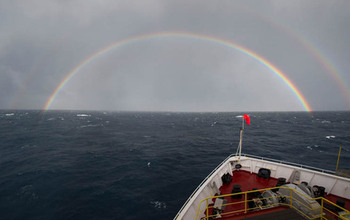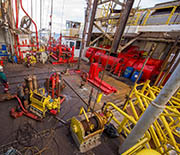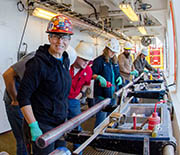News Release 17-095
Lost continent of Zealandia: Scientists return from expedition to sunken land
Two-month research cruise yields treasure trove of new information

Did scientists find Zealandia beneath the waves? Their two-month expedition was a success.
September 26, 2017
This material is available primarily for archival purposes. Telephone numbers or other contact information may be out of date; please see current contact information at media contacts.
After a nine-week voyage to study the lost, submerged continent of Zealandia in the South Pacific, a team of 32 scientists from 12 countries has arrived in Hobart, Tasmania, aboard the research vessel JOIDES Resolution.
Researchers affiliated with the International Ocean Discovery Program (IODP) mounted the expedition to explore Zealandia. IODP is a collaboration of scientists from 23 countries; the organization coordinates voyages to study the history of the Earth recorded in sediments and rocks beneath the seafloor.
"Zealandia, a sunken continent long lost beneath the oceans, is giving up its 60 million-year-old secrets through scientific ocean drilling," said Jamie Allan, program director in the U.S. National Science Foundation's Division of Ocean Sciences, which supports IODP.
"This expedition offered insights into Earth's history, ranging from mountain-building in New Zealand to the shifting movements of Earth's tectonic plates to changes in ocean circulation and global climate," Allan said.
Earlier this year, Zealandia was confirmed as Earth's seventh continent, but little is known about it because it's submerged more than a kilometer (two-thirds of a mile) under the sea. Until now, the region has been sparsely surveyed and sampled.
Expedition scientists drilled deep into the seabed at six sites in water depths of more than 1,250 meters (4,101 feet). They collected 2,500 meters (8,202 feet) of sediment cores from layers that record how the geography, volcanism and climate of Zealandia have changed over the last 70 million years.
According to expedition co-chief scientist Gerald Dickens of Rice University in the U.S., significant new fossil discoveries were made. They prove that Zealandia was not always as deep beneath the waves as it is today.
"More than 8,000 specimens were studied, and several hundred fossil species were identified," said Dickens.
"The discovery of microscopic shells of organisms that lived in warm shallow seas, and of spores and pollen from land plants, reveal that the geography and climate of Zealandia were dramatically different in the past."
The new discoveries show that the formation 40 to 50 million years ago of the "Pacific Ring of Fire," an active seafloor zone along the perimeter of the Pacific Ocean, caused dramatic changes in ocean depth and volcanic activity and buckled the seabed of Zealandia, according to Dickens.
Expedition co-chief scientist Rupert Sutherland of Victoria University of Wellington in New Zealand said researchers had believed that Zealandia was submerged when it separated from Australia and Antarctica about 80 million years ago.
"That is still probably accurate, but it is now clear that dramatic later events shaped the continent we explored on this voyage," Sutherland said.
"Big geographic changes across northern Zealandia, which is about the same size as India, have implications for understanding questions such as how plants and animals dispersed and evolved in the South Pacific.
"The discovery of past land and shallow seas now provides an explanation. There were pathways for animals and plants to move along."
Studies of the sediment cores obtained during the expedition will focus on understanding how Earth's tectonic plates move and how the global climate system works. Records of Zealandia's history, expedition scientists said, will provide a sensitive test for computer models used to predict future changes in climate.
-NSF-
-
The research vessel JOIDES Resolution about to leave Australia as it embarks on the expedition.
Credit and Larger Version -
Where were the scientists heading? A map shows the once-lost continent of Zealandia.
Credit and Larger Version -
Researchers explored deep under Zealandia's sea floor, obtaining samples of the continent.
Credit and Larger Version -
Locating the spots on Zealandia to obtain samples takes all-hands-on-deck, and a lot of equipment.
Credit and Larger Version -
Zealandia on deck: a sediment core obtained through deep-sea drilling is pored over by scientists.
Credit and Larger Version
Media Contacts
Cheryl Dybas, NSF, (703) 292-7734, email: cdybas@nsf.gov
Related Websites
NSF News: Scientists embark on expedition to submerged continent Zealandia: https://www.nsf.gov/news/news_summ.jsp?cntn_id=242506
The U.S. National Science Foundation propels the nation forward by advancing fundamental research in all fields of science and engineering. NSF supports research and people by providing facilities, instruments and funding to support their ingenuity and sustain the U.S. as a global leader in research and innovation. With a fiscal year 2023 budget of $9.5 billion, NSF funds reach all 50 states through grants to nearly 2,000 colleges, universities and institutions. Each year, NSF receives more than 40,000 competitive proposals and makes about 11,000 new awards. Those awards include support for cooperative research with industry, Arctic and Antarctic research and operations, and U.S. participation in international scientific efforts.
Connect with us online
NSF website: nsf.gov
NSF News: nsf.gov/news
For News Media: nsf.gov/news/newsroom
Statistics: nsf.gov/statistics/
Awards database: nsf.gov/awardsearch/
Follow us on social
Twitter: twitter.com/NSF
Facebook: facebook.com/US.NSF
Instagram: instagram.com/nsfgov







